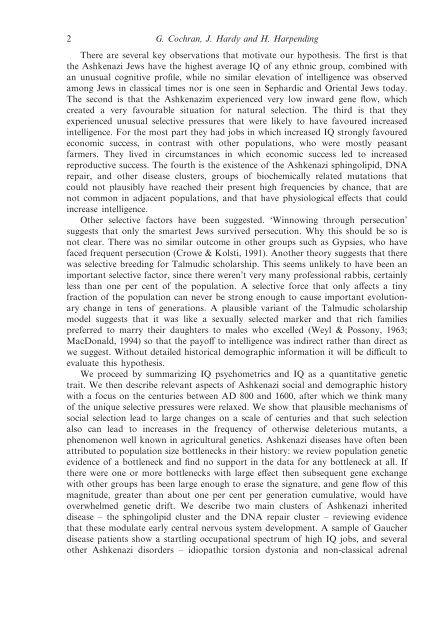natural history of ashkenazi intelligence - Henry C Harpending ...
natural history of ashkenazi intelligence - Henry C Harpending ...
natural history of ashkenazi intelligence - Henry C Harpending ...
Create successful ePaper yourself
Turn your PDF publications into a flip-book with our unique Google optimized e-Paper software.
2 G. Cochran, J. Hardy and H. <strong>Harpending</strong><br />
There are several key observations that motivate our hypothesis. The first is that<br />
the Ashkenazi Jews have the highest average IQ <strong>of</strong> any ethnic group, combined with<br />
an unusual cognitive pr<strong>of</strong>ile, while no similar elevation <strong>of</strong> <strong>intelligence</strong> was observed<br />
among Jews in classical times nor is one seen in Sephardic and Oriental Jews today.<br />
The second is that the Ashkenazim experienced very low inward gene flow, which<br />
created a very favourable situation for <strong>natural</strong> selection. The third is that they<br />
experienced unusual selective pressures that were likely to have favoured increased<br />
<strong>intelligence</strong>. For the most part they had jobs in which increased IQ strongly favoured<br />
economic success, in contrast with other populations, who were mostly peasant<br />
farmers. They lived in circumstances in which economic success led to increased<br />
reproductive success. The fourth is the existence <strong>of</strong> the Ashkenazi sphingolipid, DNA<br />
repair, and other disease clusters, groups <strong>of</strong> biochemically related mutations that<br />
could not plausibly have reached their present high frequencies by chance, that are<br />
not common in adjacent populations, and that have physiological effects that could<br />
increase <strong>intelligence</strong>.<br />
Other selective factors have been suggested. ‘Winnowing through persecution’<br />
suggests that only the smartest Jews survived persecution. Why this should be so is<br />
not clear. There was no similar outcome in other groups such as Gypsies, who have<br />
faced frequent persecution (Crowe & Kolsti, 1991). Another theory suggests that there<br />
was selective breeding for Talmudic scholarship. This seems unlikely to have been an<br />
important selective factor, since there weren’t very many pr<strong>of</strong>essional rabbis, certainly<br />
less than one per cent <strong>of</strong> the population. A selective force that only affects a tiny<br />
fraction <strong>of</strong> the population can never be strong enough to cause important evolutionary<br />
change in tens <strong>of</strong> generations. A plausible variant <strong>of</strong> the Talmudic scholarship<br />
model suggests that it was like a sexually selected marker and that rich families<br />
preferred to marry their daughters to males who excelled (Weyl & Possony, 1963;<br />
MacDonald, 1994) so that the pay<strong>of</strong>f to <strong>intelligence</strong> was indirect rather than direct as<br />
we suggest. Without detailed historical demographic information it will be difficult to<br />
evaluate this hypothesis.<br />
We proceed by summarizing IQ psychometrics and IQ as a quantitative genetic<br />
trait. We then describe relevant aspects <strong>of</strong> Ashkenazi social and demographic <strong>history</strong><br />
with a focus on the centuries between AD 800 and 1600, after which we think many<br />
<strong>of</strong> the unique selective pressures were relaxed. We show that plausible mechanisms <strong>of</strong><br />
social selection lead to large changes on a scale <strong>of</strong> centuries and that such selection<br />
also can lead to increases in the frequency <strong>of</strong> otherwise deleterious mutants, a<br />
phenomenon well known in agricultural genetics. Ashkenazi diseases have <strong>of</strong>ten been<br />
attributed to population size bottlenecks in their <strong>history</strong>: we review population genetic<br />
evidence <strong>of</strong> a bottleneck and find no support in the data for any bottleneck at all. If<br />
there were one or more bottlenecks with large effect then subsequent gene exchange<br />
with other groups has been large enough to erase the signature, and gene flow <strong>of</strong> this<br />
magnitude, greater than about one per cent per generation cumulative, would have<br />
overwhelmed genetic drift. We describe two main clusters <strong>of</strong> Ashkenazi inherited<br />
disease – the sphingolipid cluster and the DNA repair cluster – reviewing evidence<br />
that these modulate early central nervous system development. A sample <strong>of</strong> Gaucher<br />
disease patients show a startling occupational spectrum <strong>of</strong> high IQ jobs, and several<br />
other Ashkenazi disorders – idiopathic torsion dystonia and non-classical adrenal


